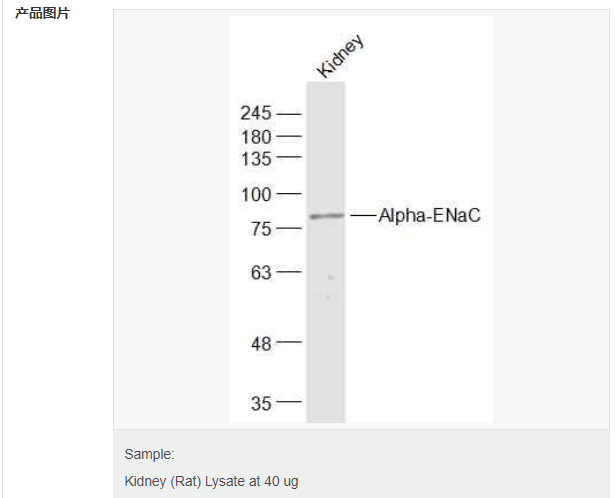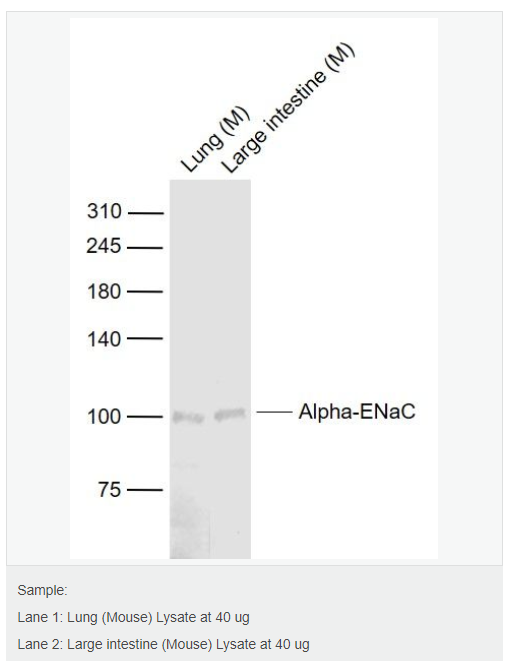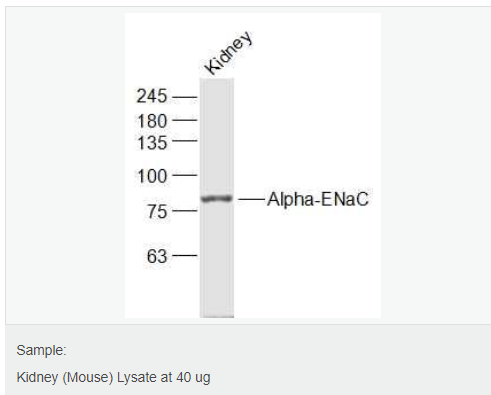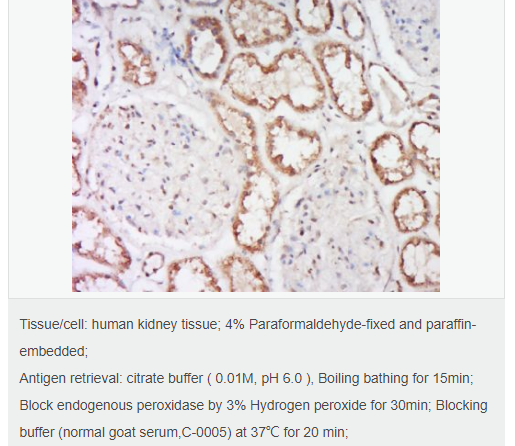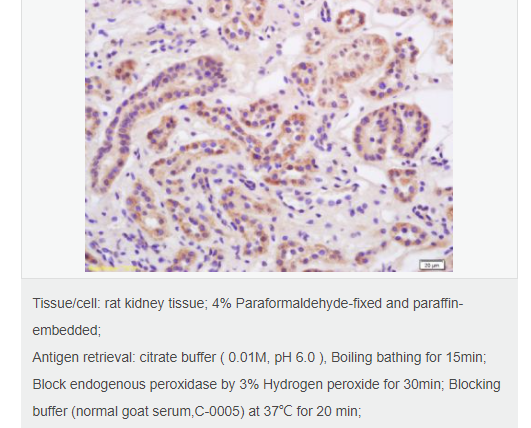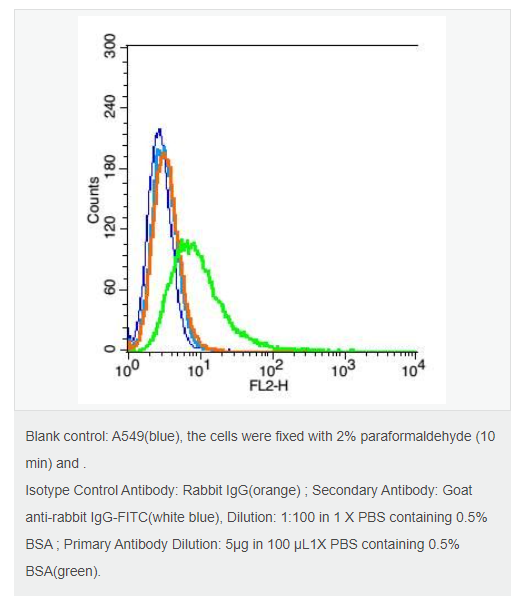
货号
产品规格
售价
备注
BN41853R-50ul
50ul
¥1486.00
交叉反应:Human,Mouse,Rat(predicted:Dog,Pig,Cow,Horse,Sheep) 推荐应用:WB,IHC-P,IHC-F,IF,Flow-Cyt,ELISA
BN41853R-100ul
100ul
¥2360.00
交叉反应:Human,Mouse,Rat(predicted:Dog,Pig,Cow,Horse,Sheep) 推荐应用:WB,IHC-P,IHC-F,IF,Flow-Cyt,ELISA
BN41853R-200ul
200ul
¥3490.00
交叉反应:Human,Mouse,Rat(predicted:Dog,Pig,Cow,Horse,Sheep) 推荐应用:WB,IHC-P,IHC-F,IF,Flow-Cyt,ELISA
| 英文名称 | Alpha-ENaC |
| 中文名称 | 钠通道蛋白α 抗体 |
| 别 名 | Alpha ENaC 2; Alpha ENaC; Alpha NaCH; Alpha-ENaC; Alpha-NaCH; Amiloride sensitive epithelial sodium channel alpha subunit; Amiloride sensitive sodium channel subunit alpha; Amiloride-sensitive sodium channel subunit alpha; ENaCa; ENaCalpha; Epithelial Na(+) channel subunit alpha; Epithelial Na+ channel subunit alpha; FLJ21883; Nonvoltage gated sodium channel 1 subunit alpha; Nonvoltage-gated sodium channel 1 subunit alpha; SCNEA; SCNN 1; SCNN1; SCNN1A; SCNNA_HUMAN; Sodium channel nonvoltage gated 1 alpha. |
| 研究领域 | 神经生物学 信号转导 细胞膜受体 |
| 抗体来源 | Rabbit |
| 克隆类型 | Polyclonal |
| 交叉反应 | Human, Mouse, Rat, (predicted: Dog, Pig, Cow, Horse, Sheep, ) |
| 产品应用 | WB=1:500-2000 ELISA=1:5000-10000 IHC-P=1:100-500 IHC-F=1:100-500 Flow-Cyt=5ug/Test IF=1:100-500 (石蜡切片需做抗原修复) not yet tested in other applications. optimal dilutions/concentrations should be determined by the end user. |
| 分 子 量 | 76kDa |
| 细胞定位 | 细胞膜 |
| 性 状 | Liquid |
| 浓 度 | 1mg/ml |
| 免 疫 原 | KLH conjugated synthetic peptide derived from human Alpha-ENaC:201-300/669 <Extracellular> |
| 亚 型 | IgG |
| 纯化方法 | affinity purified by Protein A |
| 储 存 液 | 0.01M TBS(pH7.4) with 1% BSA, 0.03% Proclin300 and 50% Glycerol. |
| 保存条件 | Shipped at 4℃. Store at -20 °C for one year. Avoid repeated freeze/thaw cycles. |
| PubMed | PubMed |
| 产品介绍 | Sodium permeable non-voltage-sensitive ion channel inhibited by the diuretic amiloride. Mediates the electrodiffusion of the luminal sodium (and water, which follows osmotically) through the apical membrane of epithelial cells. Controls the reabsorption of sodium in kidney, colon, lung and sweat glands. Also plays a role in taste perception. Function: Sodium permeable non-voltage-sensitive ion channel inhibited by the diuretic amiloride. Mediates the electrodiffusion of the luminal sodium (and water, which follows osmotically) through the apical membrane of epithelial cells. Controls the reabsorption of sodium in kidney, colon, lung and sweat glands. Also plays a role in taste perception. Subunit: Probable heterotrimer containing one alpha, one beta and one gamma subunit. A delta subunit can replace the alpha subunit. Interacts with the WW domains of NEDD4, NEDD4L, WWP1 and WWP2. Interacts with the full length immature form of PCSK9 (pro-PCSK9). Subcellular Location: Apical cell membrane; Multi-pass membrane protein. Tissue Specificity: Highly expressed in kidney and lung. Detected at intermediate levels in pancreas and liver, and at low levels in heart and placenta. Isoform 1 and isoform 2 predominate in all tissues. Expression of isoform 3, isoform 4 and isoform 5 is very low or not detectable, except in lung and heart. Post-translational modifications: Ubiquitinated; this targets individual subunits for endocytosis and proteasome-mediated degradation (By similarity). ENaC cleavage by furin, and subsequently by prostasin (PRSS8), leads to a stepwise increase in the open probability of the channel as a result of release of the alpha and gamma subunit inhibitory tracts, respectively. DISEASE: Pseudohypoaldosteronism 1, autosomal recessive (PHA1B) [MIM:264350]: A rare salt wasting disease resulting from target organ unresponsiveness to mineralocorticoids. PHA1B is a severe form involving multiple organ systems, and characterized by an often fulminant presentation in the neonatal period with dehydration, hyponatremia, hyperkalemia, metabolic acidosis, failure to thrive and weight loss. Note=The disease is caused by mutations affecting the gene represented in this entry. The degree of channel function impairment differentially affects the renin-aldosterone system and urinary Na/K ratios, resulting in distinct genotype-phenotype relationships in PHA1 patients. Loss-of-function mutations are associated with a severe clinical course and age-dependent hyperactivation of the renin-aldosterone system. This feature is not observed in patients with missense mutations that reduce but do not eliminate channel function. Markedly reduced channel activity results in impaired linear growth and delayed puberty (PubMed:18634878). Bronchiectasis with or without elevated sweat chloride 2 (BESC2) [MIM:613021]: A debilitating respiratory disease characterized by chronic, abnormal dilatation of the bronchi and other cystic fibrosis-like symptoms in the absence of known causes of bronchiectasis (cystic fibrosis, autoimmune diseases, ciliary dyskinesia, common variable immunodeficiency, foreign body obstruction). Clinical features include sub-normal lung function, sinopulmonary infections, chronic productive cough, excessive sputum production, and elevated sweat chloride in some cases. Note=The disease is caused by mutations affecting the gene represented in this entry. Similarity: Belongs to the amiloride-sensitive sodium channel (TC 1.A.6) family. SCNN1A subfamily. SWISS: P37088 Gene ID: 6337 Database links: Entrez Gene: 6337 Human Entrez Gene: 20276 Mouse Omim: 600228 Human SwissProt: P37088 Human SwissProt: Q61180 Mouse Unigene: 591047 Human Unigene: 144114 Mouse Unigene: 9808 Rat Important Note: This product as supplied is intended for research use only, not for use in human, therapeutic or diagnostic applications. αENaC |
